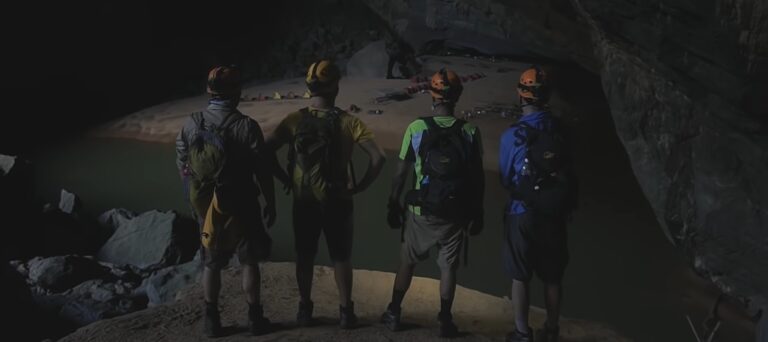For me, caves are more than just geological wonders; they are gateways to a time long past.
Within their depths, I sense the echo of ancient civilizations seeking shelter, finding solace, or connecting with something greater than themselves. The caves have witnessed the sacred rituals and stories woven by our ancestors, making them sacred sanctuaries that hold the essence of human history.
The exploration of these cavernous wonders is an invitation to embrace the unknown, to unravel the mysteries that lie beneath the Earth’s surface. So today I want to introduce you to some of the most interesting mystical caves around the world. Brace yourselves, the secrets of the past are coming!
10 Most Captivating Caves Around the World:
1. Hang Son Doong: Vietnam’s Subterranean Marvel
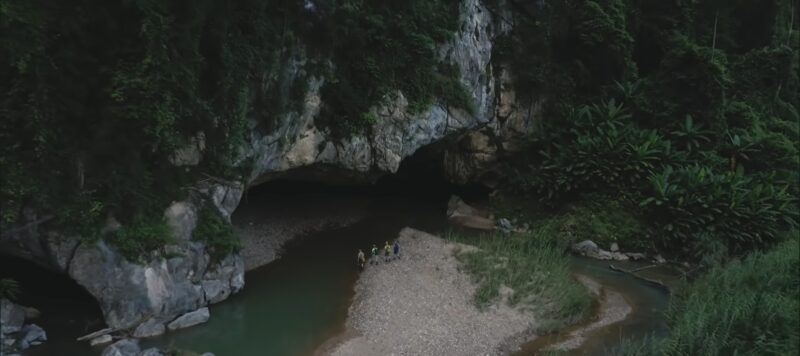
Deep within Vietnam’s Phong Nha-Ke Bang National Park, you’ll find the world’s largest cave – Hang Son Doong. This colossal subterranean wonder, discovered only a few decades ago, still holds untold mysteries. Its name, translating to ‘Mountain River Cave,’ alludes to the mighty river running through its cavernous expanse.
Hang Son Doong’s scale is truly mind-boggling. Some sections are so vast they harbor their own rainforests, complete with wildlife and weather systems. Sunlight filters through sizable roof collapses, or dolines, nourishing life in this otherwise dark realm. Its most prominent doline, known as Watch Out for Dinosaurs, features lush vegetation and clouds – an almost fantastical landscape.
A journey into Hang Son Doong is a thrilling adventure, traversing immense caverns, navigating underground rivers, and marveling at otherworldly stalagmites. Its sheer size and beauty make it a bucket-list destination for cave enthusiasts and casual explorers alike.
2. Reed Flute: China’s Illuminated Underground Wonderland
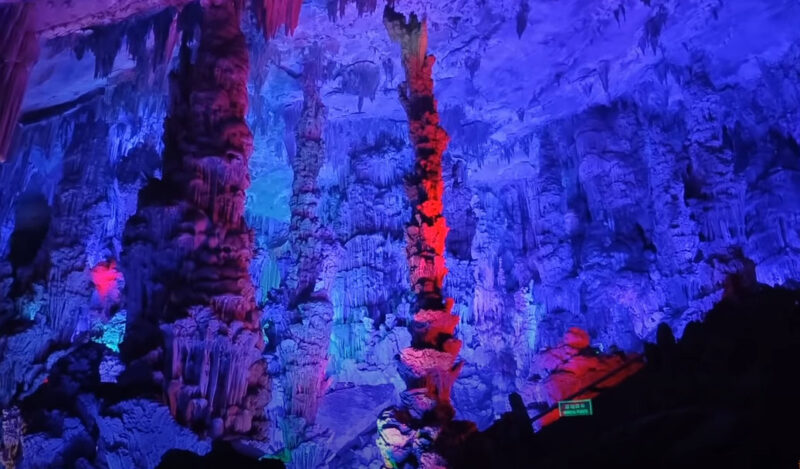
Located in the picturesque city of Guilin, China, the Reed Flute is a subterranean wonderland. This enchanting cave gets its name from the abundance of reeds growing near the entrance, traditionally used to make flutes. Its geological history dates back over 180 million years, and its formations tell a fascinating tale of time and nature’s artistry.
The interior of the Reed Flute is adorned with a myriad of stalactites, stalagmites, and rock formations, illuminated by multi-colored lights. Its diverse formations, shaped like mountains, waterfalls, and even creatures, inspire awe and imagination. The Crystal Palace of the Dragon King, the cave’s largest chamber, can accommodate up to 1000 people and presents an awe-inspiring spectacle.
Beyond its natural allure, Reed Flute is imbued with cultural significance. Ancient inscriptions dating back to the Tang Dynasty (792 AD) are visible on the walls, offering insights into China’s rich history. Whether for its geological wonders or historical resonance, Reed Flute holds a unique charm for every visitor.
3. Postojna: Slovenia’s Subterranean Gem
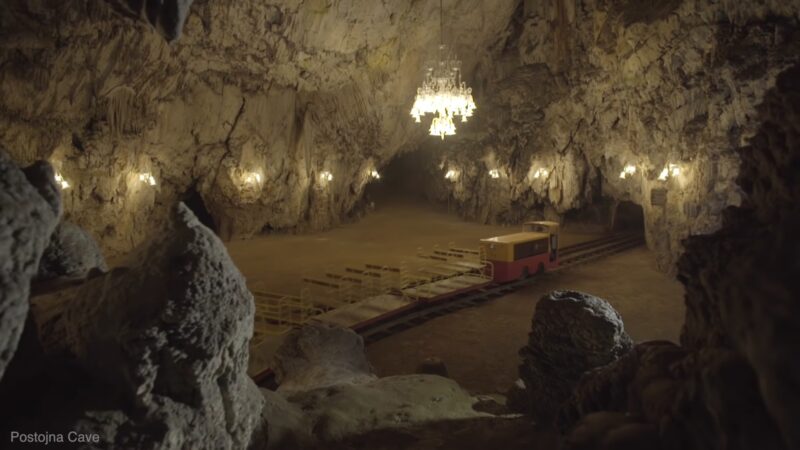
Postojna Cave, located in the southwestern region of Slovenia, is one of Europe’s most extensive karst cave systems. This enchanting labyrinth of tunnels, galleries, and halls spans over 24 kilometers, inviting visitors on an extraordinary underground journey.
Its most notable features include its impressive stalactite and stalagmite formations, such as the red-curtain adorned Concert Hall and the towering Brilliant stalagmite. As visitors traverse the winding paths, a unique ecosystem reveals itself. Postojna is home to the “human fish” or Olm, a rare aquatic salamander found only in the subterranean waters of the Dinaric Alps.
It has a rich human history too, serving as a refuge, a strategic military outpost, and a venue for concerts due to its exceptional acoustics. Its stalagmite-decorated Gothic Chapel has even witnessed weddings! This blend of natural wonder, biodiversity, and cultural history make Postojna a compelling destination.
4. Luray Caverns: Virginia’s Captivating Complex
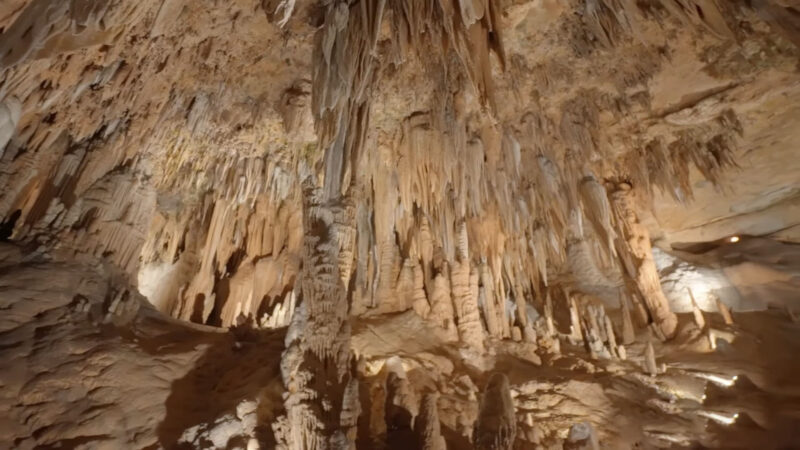
Nestled in the Shenandoah Valley of Virginia, USA, the Luray Caverns are a captivating spectacle of nature’s craftsmanship. Discovered in 1878, they house a mesmerizing array of formations in varying shapes and sizes, each telling a tale of the Earth’s geological past.
Towering stone columns, shimmering draperies, crystal-clear pools, and the world’s only Stalacpipe Organ dominate its landscape. This unique musical instrument uses rubber mallets to tap stalactites of various sizes, producing musical tones akin to those of xylophones.
The cavern’s most notable formation, the Double Column, is a majestic meeting of a stalactite and stalagmite, symbolizing the slow yet persistent dynamism of nature.
Luray Caverns extend beyond the fascinating formations. The Dream Lake reflects the stalactites above, creating an optical illusion of an underwater stellarium.
Whether it’s the echoing notes of the Stalacpipe Organ, the Giant’s Hall’s towering columns, or the Dream Lake’s mirrored illusions, they offer a memorable subterranean adventure.
5. Cenotes: Mexico’s Natural Sinkholes of Serenity
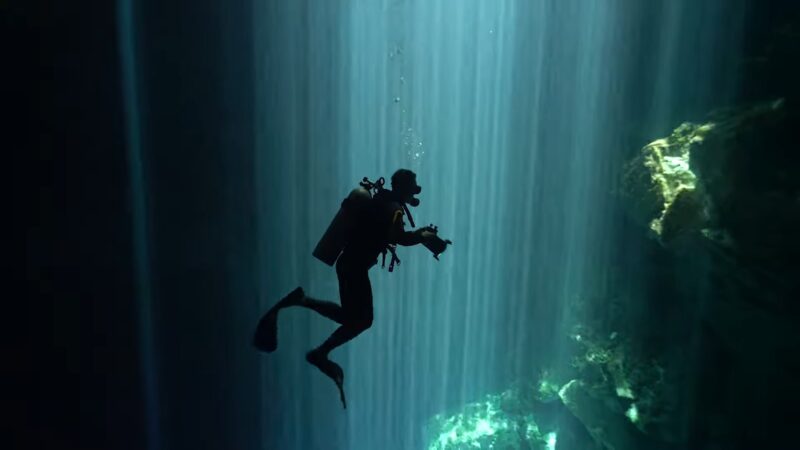
The Yucatán Peninsula in Mexico is known for its fascinating geological feature known as cenotes. Unlike the underwater waterfalls in Mauritius, which are simply optical tricks, cenotes are genuine sinkholes formed by the erosion of limestone bedrock. These natural formations reveal the underlying groundwater and form serene turquoise pools that are encircled by vibrant plant life.
Revered by the ancient Mayans as sacred wells, cenotes were sites for ritualistic offerings and sacrifices.
Cenotes like Ik Kil and Dos Ojos are not just breathtaking sights but also popular spots for swimming, snorkeling, and diving. As you descend into these cool, freshwater pools, you enter a serene, otherworldly realm. Overhead, the sunlight filters through the opening, illuminating the clear waters and casting a mystical aura.
The cenotes are also gateways to an extensive network of underwater caves and caverns, inviting exploration by divers. The skeletal remains and pottery shards found here offer glimpses of Mayan history. For its unique blend of natural beauty, history, and adventure, a cenote visit is a must for anyone exploring the Yucatán.
6. Mammoth Cave: Kentucky’s Vast Underground Labyrinth
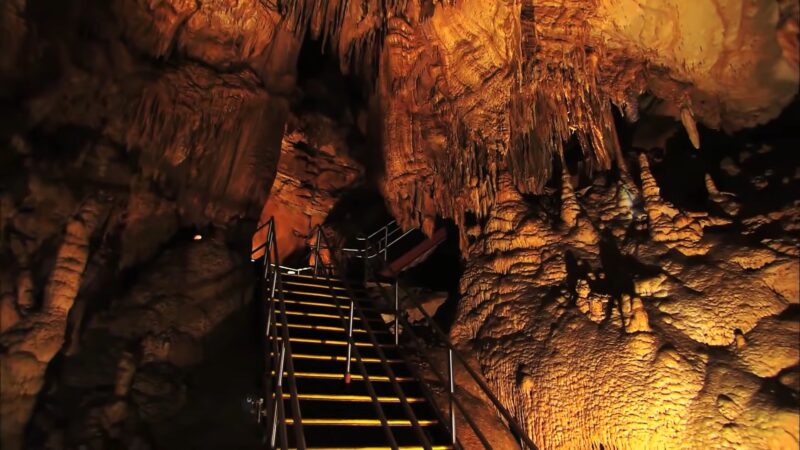
In the heart of Kentucky, USA, sprawls the world’s longest known cave system – Mammoth Cave. This subterranean labyrinth, with more than 400 miles of surveyed passageways, is a testament to the Earth’s age and geological diversity. It’s a maze of vast chambers, complex labyrinths, and unique formations, all shrouded in an alluring aura of mystery and antiquity.
The tour of Mammoth unfolds like a narrative of the Earth’s geological history, with each formation holding a unique story. Key attractions include the enormous Rotunda, the Bottomless Pit, and the Frozen Niagara, a flowstone formation resembling a frozen waterfall.
These fascinating features bear testament to the ceaseless processes that have shaped the Earth over millions of years.
Mammoth Cave’s rich biodiversity further adds to its appeal. It’s home to various cave-adapted species, including the endangered Kentucky cave shrimp. Its intricate interconnected passages make it a critical habitat for these unique life forms.
7. Cango Caves: South Africa’s Ancient Subterranean Marvels
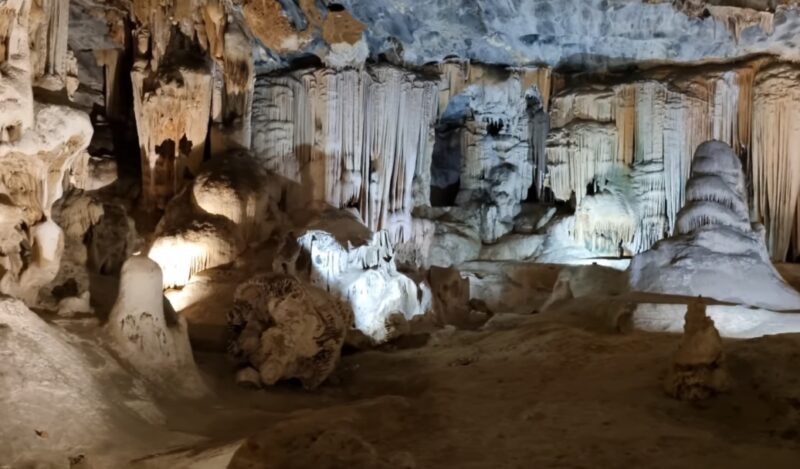
The Cango Caves are a series of dripstone caverns that rank as one of the world’s great natural wonders. They are situated at the foothills of the Swartberg range in South Africa’s Western Cape.
Its chambers display an incredible collection of stalactites, stalagmites, and helictites in all their mystic grandeur, etching a breathtaking spectacle on the cave’s walls and ceilings.
The awe-inspiring limestone formations in them have intriguing names like ‘Cleopatra’s Needle’, ‘The Leaning Tower of Pisa’, and ‘The Organ Pipes’.
The stalagmites and stalactites here have been forming for millennia, sculpted by nature into fascinating shapes. The cathedral-like Van Zyl’s Hall, the cave’s largest chamber, is especially renowned for its acoustic qualities and ornate formations.
Evidence of early human habitation has been found within the caves, indicating that they served as a shelter for Stone Age humans. These prehistoric dwellers left behind artifacts and paintings, offering a glimpse into an ancient era.
The blend of stunning natural formations and archaeological significance makes Cango Caves a must-visit destination for any traveler to South Africa.
8. Benagil Sea Cave: Portugal’s Coastal Wonder
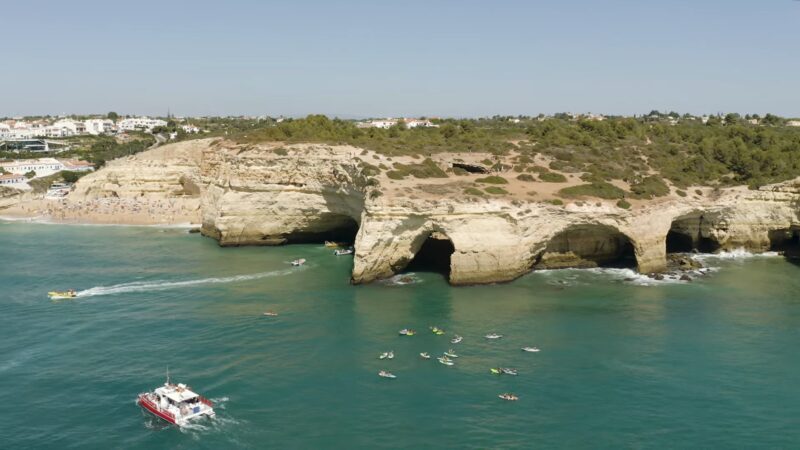
It is a spectacular coastal marvel located in the small fishing village of Benagil on Portugal’s Algarve coast. This dome-shaped cave, hollowed out by centuries of Atlantic Ocean waves battering against the sandstone cliff, is one of the most picturesque sea caves in the world.
Its distinctive feature is the large circular opening in its roof, fondly known as “the eye,” through which sunlight streams, creating an ethereal light show on the sandy floor and turquoise waters. The sandy beach, bathed in a surreal glow, provides a tranquil spot to admire the turquoise sea and the dramatic cliff faces.
The only way to access the Benagil Sea Cave is by water – by swimming, kayaking, or taking a boat tour. As you emerge into its sunlit interior, you can’t help but marvel at this stunning natural cathedral created by the relentless forces of nature.
9. Waitomo Glowworm Caves: New Zealand’s Bioluminescent Underground Realm
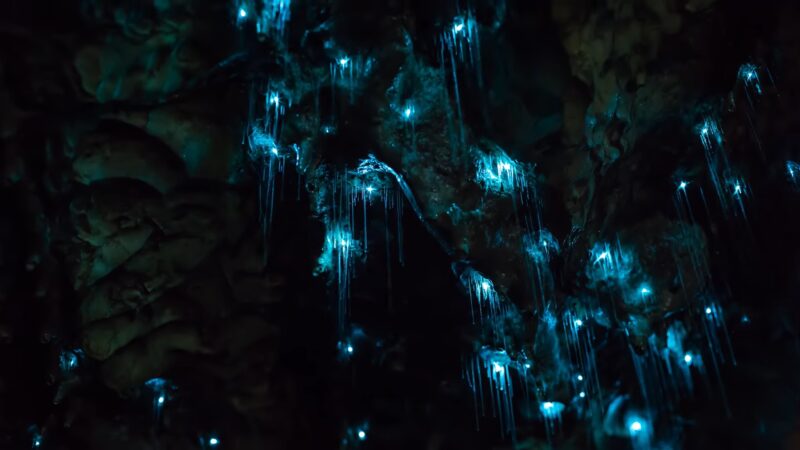
New Zealand’s Waitomo region is home to a mesmerizing subterranean spectacle – the Waitomo Glowworm Caves. These offer an enchanting journey into a twinkling underground universe, thanks to millions of native glowworms (Arachnocampa luminosa) illuminating the darkness.
As visitors glide through the silent, pitch-dark caves on a boat, they encounter a starry spectacle reminiscent of a clear night sky. These ‘stars’ are, in fact, bioluminescent glow worms clinging to the roof, creating a breathtaking light show. The Glowworm Grotto, in particular, offers an unmatched view of this luminescent spectacle.
They also feature impressive limestone formations, including the Cathedral, renowned for its superb acoustics. However, it’s the ethereal luminescence of the glowworms that has drawn visitors to these caves for over a century. This magical, alien-like phenomenon makes Waitomo Glowworm Caves an unmissable stop on any New Zealand itinerary.
10. Jenolan Caves: Australia’s Majestic Subterranean Wonderland
These spectacular caves which are located in the heart of Australia’s Blue Mountains.
They house numerous show caves, each unique in its form and character.
The Lucas Cave, with its cavernous chambers and the exquisite Broken Column, and the Imperial Cave, known for its impressive fossil deposits, are particularly noteworthy. The pure, underground River Styx that leads into the Pool of Cerberus, presents a stunningly beautiful scene.
Not only are these caves a feast for the eyes, but they are also rich in cultural significance. To the local Gundungurra and Wiradjuri people, they hold spiritual importance and feature in their Dreamtime stories.
FAQs:
How deep does the Postojna Cave go?
The deepest part of it reaches a depth of around 115 meters below the surface.
Are there any restrictions or guidelines for visiting Ik Kil Cenote?
Visitors are advised to follow safety guidelines provided by the cenote management, including rules on swimming, diving, and respecting the environment.
What other attractions or activities can visitors combine with a visit to the Benagil Sea Cave?
Visitors can combine it with exploring the nearby beaches, coastal hiking trails, or visiting other scenic spots along the Algarve coast.
Can visitors explore Mammoth Cave on their own?
While guided tours are recommended for a safe and enriching experience, there are limited opportunities for experienced and permitted individuals to explore certain sections independently.
What is the duration of a typical Hang Son Doong expedition?
A typical expedition to Hang Son Doong lasts around four to five days, allowing visitors to fully experience its grandeur.
Conclusion
Our planet’s subterranean world, filled with spectral beauty, geological wonders, and biological diversity, never ceases to captivate me.
Each of these remarkable caves – from the lush microcosm within Hang Son Doong to the luminescent magic of Waitomo – serves as a testament to the Earth’s ancient past and the ceaseless dynamism of nature.
Exploring these caves not only indulges our sense of adventure but also deepens our connection with the planet. It reminds us of the complexity and fragility of the ecosystems that exist beneath the surface and the need to conserve these natural treasures for generations to come.
After all, as we delve deeper into these subterranean wonders, we delve deeper into understanding the Earth’s secrets and, ultimately, our place within its vast tapestry.
Related Posts:
- 9 Upside Down House Attractions Around the World To…
- Are Red-Eye Flights Dangerous? Flying into the Twilight Zone
- How Zipcar Fares for Getting Around Town - Review,…
- Diablo Lake Washington - Turquoise Paradise That You…
- Unlocking the Secrets: How Instagram Celebrities…
- Does It Snow In Spain? Should You Expect a Chilly Surprise?

